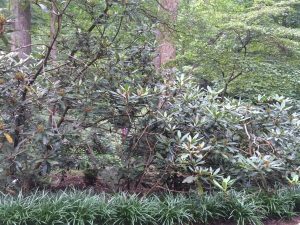
Ice and snow covered Picea pungens
Winter has come early again this year and I don’t think any of us are ready. However, I just read an article by Stacey Hirvela for Proven Winners®Color Choice® and thought I would share some of her knowledge with you.
The purpose of Stacy ‘s article was reassuring gardeners that most shrubs will live through the winter as long as you have chosen them for zone hardiness, that there isn’t really anything else you need to do. I will add that the reason most plants die during the winter is poor drainage. Heavy clay soils, which most of us seem to have, retain water and most plant roots do not like to be constantly wet; therefore, they rot. Actually, the best way to prevent winter root rot is amendment of the soil. It’s too late for this year but next Spring or summer, once the soil is workable, I would suggest adding Turface MVP, an inorganic grit that does not decay but allows air and water to penetrate the soil.
As Stacy mentions, there is a difference between surviving the winter and thriving so she has four tips for giving hardy shrubs every possible advantage.
Apply a two inch layer of shredded hardwood bark as a mulch around the entire root zone of the plant. I would add a caveat: Do not apply it against the bark; leave at least a half inch to an inch of uncovered space. Too much moisture against bark encourages disease. Mulch will retain moisture all year round but it also insulates soil temperature even when the soil is frozen.
Don’t let your garden go into the winter with dry soil. Fortunately, here in Cleveland, we’ve been getting either rain or snow lately so you will probably not need to water until the ground freezes. However, if we do go through a dry spell, you should water, particularly plants that were installed this year.

Buddelia ‘African Queen’ in late September, behind stalks and deadheads of Rudbeckia maxima, is very tall but I do not prune until Spring.
With a few exceptions, do not prune. Stacy says that leaving the plant intact provides extra protection for the lowest and most crucial buds on the plant. Additionally, waiting until the buds begin to emerge in the spring allows you to better gauge where to prune. If you are a fan of wildlife, you know that dense shrubs provide shelter and protection as well as food if the shrub has berries or seedheads. My exception to the no prune rule is roses but prune them in the fall only if they have long canes that will whip around in the wind. You could prune them halfway and then further down in the spring.

Ilex verticillata in winter
Even wildlife lovers do not want their shrubs destroyed by animals. This late in the year, insects aren’t typically a problem but our furry “friends” can be. As Stacy says, rabbits, mice, and voles typically chew on branches to consume the tender, moist layer just below the bark. This type of damage is usually seen at the base of the plant, although when it snows, you’ll see damage further up the branches. Damage higher up is usually from the deer who start eating at the height of their mouths. The best physical protection for your plants is netting, wire mesh (either hardware cloth or chicken wire) or even burlap. You could also try a deer repellent. I’ve been very happy with I Must Garden Deer Repellent because it is not obnoxious to human noses but seems to be very effective in deterring the deer.

I would add a fifth tip. If you have broad leaf evergreens, e.g. rhododendrons or azaleas on the south or west side of your house, spray with an anti-dessicant. During the winter, we always get some warm, sunny days that cause such plants to transpire which means that even though the ground is frozen, the plant is losing water through its leaves. That is why we frequently see leaves that either have browned edges or are totally brown.
So save your energy for next spring when there will be so much to do.


2 Comments